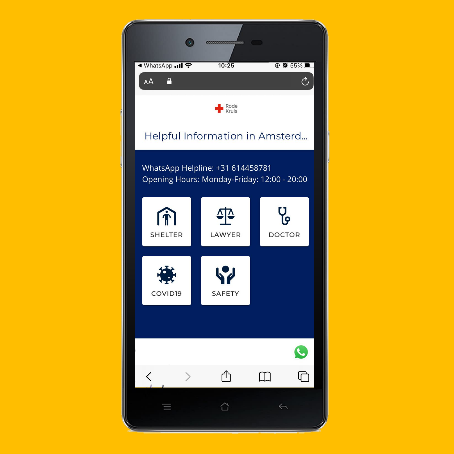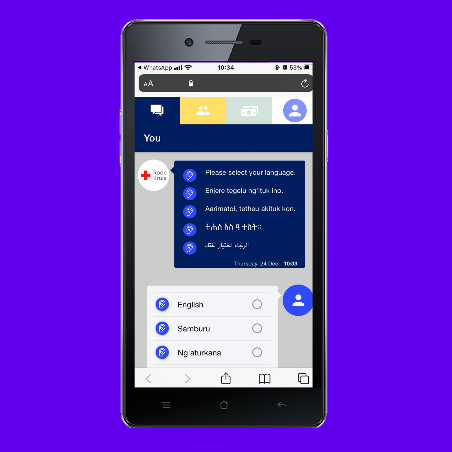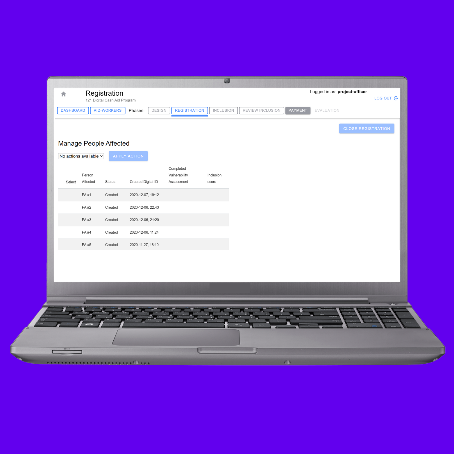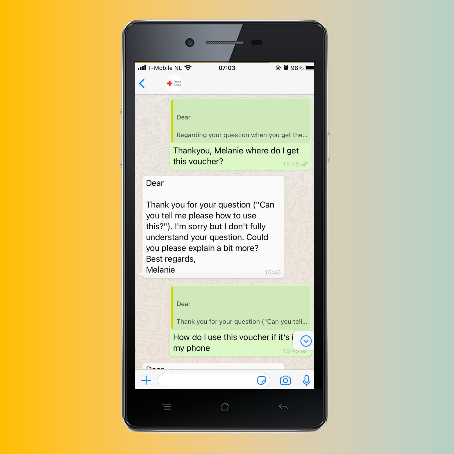Escrito por Sander Houston
El mundo está siendo testigo de niveles récord de migración y desplazamiento, lo que plantea algunos de los retos humanitarios más importantes de la era moderna. En todo el planeta, las personas que emigran o se ven desplazadas de sus hogares se enfrentan a riesgos inaceptables y con demasiada frecuencia se ven privadas de las necesidades básicas y la protección que necesitan para garantizar su seguridad, dignidad y derechos. En todo el mundo hay 70,8 millones de migrantes desplazados involuntariamente. Este reto también es aplicable a los Países Bajos. Hay necesidad de refugio y escasez de información sobre dónde obtener la ayuda adecuada (como acceso a alimentos y asistencia sanitaria). COVID plantea ahora un reto adicional para este colectivo. En respuesta a este reto, la Cruz Roja Holandesa creó un programa que combina el acceso a información útil y la ayuda en efectivo.
Digital technology has the potential to transform how programs operate. Data management and digital payment platforms are already demonstrating how new technologies can have a great impact on convenience for people receiving cash assistance and also efficiencies, including for the aid organization. 121 is a platform built on the knowledge and skill of a consortium of humanitarian, technical, and academic partners across numerous locations. The 121 platform consists of three easy-to-use Cash-Based Aid products for people affected, such as undocumented migrants, and aid workers alike in response to the increasing global demand for cash and voucher-based aid in the humanitarian sector.
En este blog se comparten los resultados del proyecto piloto 121 que se llevó a cabo en los Países Bajos el 1 de noviembre.st 2020 hasta el 31 de mayo de 2021
El piloto
Anne van Berkel (Project Leader of The Netherlands Red Cross) explains how the pilot addresses both the need for information as the need for food: ‘the pilot can be divided into three pillars: Información útil, Cash Aid and the WhatsApp Helpdesk. Learnings from earlier contact and co-designs with undocumented migrants pointed to the need for Cash help. This is where 121 came in’.
El proyecto piloto consiste en el envío semanal de vales digitales en efectivo a través de WhatsApp, el servicio de ayuda de WhatsApp y el sitio web de información útil. Estos productos se pusieron a prueba en Ámsterdam y Utrecht, con inmigrantes indocumentados que se encontraban bajo mayor presión debido a la crisis del COVID. . Este programa distribuye semanalmente vales digitales de supermercado (Digital Cash Vouchers) a un grupo seleccionado de inmigrantes indocumentados. Estos inmigrantes indocumentados forman parte del Programa de Alimentos de la Cruz Roja Holandesa (un programa de ayuda alimentaria relacionado con el COVID) o están en la lista de espera de la normativa holandesa LVV. El LVV-regulation es un ensayo del gobierno holandés, en el que cinco municipios y otras organizaciones proporcionan alojamiento y asesoramiento a inmigrantes indocumentados. La persona recibe el supervale a través de Whatsapp y puede utilizarlo para pagar en el supermercado, sin necesidad de imprimirlo y también sin conexión. Además de los vales digitales en efectivo, el proyecto piloto ofrecía información/recomendaciones sobre alojamiento, asistencia médica, asesoramiento jurídico y COVID para inmigrantes indocumentados en los Países Bajos, a través de un sitio web público.
El objetivo del proyecto piloto es promover el bienestar físico y mental de los inmigrantes indocumentados reduciendo la incertidumbre y el estrés sobre su supervivencia diaria. El proyecto piloto ha contado con el apoyo de la Fundación Philips, que también ha participado en una fase anterior del desarrollo del 121.
Los vales y la información útil permiten un primer contacto con los inmigrantes indocumentados. A continuación, el servicio de asistencia ayuda a continuar las relaciones con los inmigrantes indocumentados. La información que se recibe en el servicio de asistencia puede utilizarse para mejorar el proceso en su conjunto.
Someone that knows what it’s like to be an undocumented migrant for a while is John. He knows from experience how urgent the need for this innovative emergency aid is and how important it is that it is designed from the user’s perspective. That was his motivation to help as someone with practical knowledge of the issue in the creation of the Helpful Information Web App. “From the moment the Immigration and Naturalization Service rejected my asylum application, I was on the street. I went to Amsterdam, where I was able to stay reasonably under the radar of the authorities. I heard from the asylum seekers center that after a rejection you can knock on the door of a number of places for food or shelter. But where exactly, how and which? It was maddening. How can you seek help from authorities if you are just trying to hide from the authorities? I became depressed, anxious and very lonely. This aid package from the Red Cross makes a huge difference when you’re on the street. I wish others who are in temporary need that they can also increase their chances of survival via Helpful Information, the WhatsApp Helpdesk or the vouchers.”
Digital Community engagement and accountability (CEA) is an approach to Red Cross Red Crescent programming and operations. It is supported by a set of activities that help put communities at the center of what they do, by integrating communication and participation throughout the program cycle or operation. When asked what role Digital CEA plays in this pilot Jonath Lijftogt (Coordinator & Digital Community Engagement & Accountability at 510) said: ‘The pilot is a way of having direct and sustainable contact with undocumented migrants. That’s the essence of Community Engagement and Accountability’.
Aplicación web de información útil
‘There is already a lot of help available in The Netherlands but it’s not always easy to find it. The Helpful Information Web App offers a solution.’ says Van Berkel. The Helpful Information Web App is an information source for undocumented migrants with available help in the Netherlands. The Web App is available to everyone and the current information spans shelter, medical assistance, legal advice, and COVID-19. When building an app it is important to center it around the user. The Web App is a direct result of co-designing and user testing with undocumented migrants whose knowledge and experience designed this Web App. Human Centered Design methodologies and the uptake demonstrates the importance of involving the human stakeholder’s perspective in all steps of the product creation process. When Orla Canavan (Strategic Product Designer lead at 510) was asked why 510 uses Human Centered Design she said: ‘In 510 it’s easy to come up with a technical solution and assume it will work for the end user. Most all of us in this team have never experienced what it’s like to access information on a broken smartphone, with limited battery, leaning by a building to catch Wi-Fi at 8 o’clock at night just to find somewhere to sleep. These are the things we learn and adapt technology towards when we use Human Centered Design. We can’t solve everything with technology but we can at least make sure that when we do offer technology it’s at least useable.’
Más información sobre el diseño centrado en el ser humano aquí.

Aplicación web de información útil
121 plataforma
With the 121 platform, The Netherlands Red Cross and 510 aim to make Cash-Based Aid safe, fast, and fair, and to help people affected, by disasters (such as hurricanes, floods, drought, epidemics, and conflict) meet their own needs. 510 Co-designs with People Affected by disasters and Aid Workers and uses robust and available technology to create the solutions needed. Van Berkel adds by saying: ‘it’s a platform that allows us to easily reach and work together with vulnerable people. It optimizes the process of aid assistance by creating a feedback loop and it has the potential to adapt to different types of help’. Melanie Miltenburg (510 coordinator of the pilot) adds by saying: ‘the platform enables us to quickly scale up the number of people we support, with more or less the same capacity from our side. That’s of course a very important feature for emergency aid.’
La aplicación de automatrícula, el portal HO y el bono digital en metálico
La plataforma 121, en este piloto, tiene dos interfaces (que han sido construidas internamente en consorcio con varios socios): la app de Auto Registro y el Portal de la Organización Humanitaria (OH). En la aplicación de autorregistro, los inmigrantes indocumentados pueden inscribirse en los programas. En el Portal de Organizaciones Humanitarias, las organizaciones, como la Cruz Roja Holandesa, pueden gestionar el programa desde el registro hasta el envío de pagos, como vales digitales de supermercado o Mpesa. Esta plataforma puede facilitar el registro, la validación, la inclusión y el pago en un programa de efectivo y vales.
La aplicación Self Registration App se diseñó conjuntamente con personas afectadas por catástrofes en todo el mundo, preguntándoles sobre su experiencia antes, durante y después de recibir ayuda.
Más información aquí.
El Portal de la OS se diseñó conjuntamente con los trabajadores humanitarios que respondían a estas catástrofes.
Más información aquí.
Both applications were co-designed to ensure the end users’ digital knowledge and preferences were taken into account and when needed training and assistance was given.
Más información sobre el uso de la aplicación de autoempadronamiento en Kenia aquí.


La aplicación de automatrícula El portal HO
Servicio de asistencia WhatsApp
The WhatsApp Helpdesk is developed for People Affected to understand more about the aid they applied for, or to let us know if they face any problem with e.g. the registration process or receiving the voucher. They can also approach the Helpdesk for other topics, such as to learn where to find shelter, medical care or legal support, or even where to find a language training. The Helpdesk improves the connection with Aid Workers who can help with questions they might have. ‘The WhatsApp Helpdesk ties the program together’, says Miltenburg. She continues by saying: ‘It’s surprising, and contradicting my own initial expectations, how personal digital communication can be. From the messages we get, you can read that people feel it as a personal conversation, and let go of shame or other barriers to share their concerns. Moreover, it is the person him/herself that decides if and when to contact us, not depending on when we contact them for feedback, as in traditional projects’.
Como el Helpdesk está disponible 7 días a la semana, proporciona a las Personas Afectadas un acceso rápido y fácil a la Organización Humanitaria. Además, las preguntas y los comentarios recibidos a través del servicio de asistencia proporcionan a la organización humanitaria información valiosa sobre el contexto, las necesidades y las limitaciones de las personas afectadas, que puede utilizarse para seguir desarrollando los servicios y productos.

Servicio de asistencia WhatsApp
Organizaciones implicadas
La plataforma 121 se basa en los conocimientos y competencias de un consorcio de socios humanitarios, técnicos y académicos de numerosos lugares.
Más información sobre el consorcio aquí.
La plataforma 121 se puso a prueba en los Países Bajos con inmigrantes indocumentados. Se trata de un grupo que, debido a su situación, suele preferir pasar desapercibido y, por tanto, es difícil llegar a él. Las organizaciones asociadas que apoyan específicamente a este grupo pusieron a la Cruz Roja Holandesa en contacto con él. En la siguiente lista figuran las organizaciones asociadas que participaron en este proyecto piloto y que se ampliarán en el futuro a medida que se desarrolle el programa: Loket Ongedocumenteerden Amsterdam (LOA), Aanmeldloket Utrecht, STIL Utrecht, Filipino LGBT Europe (Amsterdam) y Stap Verder (Amsterdam).
510’s role
510 supported The Netherlands Red Cross domestic department in providing food aid to undocumented migrants by co-designing and implementing the 121 platform. This enables undocumented migrants and other people affected to efficiently and safely register themselves to apply for food aid. The 121 platform enables sending digital vouchers through WhatsApp. It also enables aid workers and humanitarian organizations to manage and coordinate cash and voucher programs. The system, after registration, helps humanitarian organizations in making sure that the right people are part of the programs and keeps these people updated throughout the process. Lars Stevens, Project coordinator of 121 at 510, explains the benefit of this system for humanitarian organizations by saying: ‘Reducing uncertainty and creating clarity is one of the main goals for humanitarian organizations in helping people.’ These updates occur every week. The system is also able to monitor the usage of the vouchers and creating a clear overview of whether vouchers were properly received and (fully) used. The digital system allowed for the program to be scaled up a lot quicker while the capacity of the humanitarian organization stayed relatively the same. This is a huge benefit of the digital system: ‘Effectively, by a few pushes of a button people receive digital vouchers which they can use in the supermarket to buy groceries’ concludes Lars Stevens.
Principales resultados
- La ayuda ofrecida (vale, información útil, servicio de asistencia) ayuda a las personas a reducir el estrés de su vida cotidiana mediante una estructura coherente y autonomía, lo que contribuye a mejorar su salud mental y física.
- El proceso digital de registro, recepción y uso del bono es más flexible y cómodo para los inmigrantes indocumentados, ya que no depende de una hora y un lugar determinados. Además, el proceso es totalmente anónimo. Esto contribuye al sentimiento de dignidad.
- La persona sabe cómo encontrar el servicio de ayuda de Whatsapp cuando lo necesita o tiene una pregunta. El servicio de ayuda por Whatsapp es muy accesible y rápido, y reduce las barreras culturales o prácticas para pedir ayuda.
- La aplicación web de información útil se visita con frecuencia para saber dónde acudir en caso de necesidades específicas, pero también permite a la Cruz Roja compartir información en función de las necesidades que vayan surgiendo (por ejemplo: La oportunidad de vacunación COVID para inmigrantes indocumentados se actualiza diariamente en este sitio web.
- El uso de Digital Aid ha permitido a la Cruz Roja Holandesa ampliar rápidamente el programa a medida que surgen nuevas necesidades.
Cómo medimos los principales resultados
We measured the main findings both in an quantitative and qualitative way. From a quantitative point we collected data through the registration system, Helpful Information App (clicks), and Helpdesk (log sheet). For qualitative measurements we elicited feedback from undocumented migrants in the program by sending them an online survey and by conducting interviews . We also conducted interviews with the partner organizations involved . ‘Relevant information about individuals and communities in need can help provide effective and personalized humanitarian aid.’ says Joachim Ramakers (Policy Advisor Data Responsibility at 510). He continues by saying: ‘Our data responsibility policy addresses the responsible processing of data concerning ethical standards and in principles in the humanitarian context, bearing in mind potential consequences and taking measures to avoid putting individuals or communities at risk.’
Más información sobre nuestra política de responsabilidad de datos aquí.
Próximos pasos
La siguiente fase del programa incluirá la elaboración de un plan de acción que incluya la planificación, un presupuesto detallado y pasos para la recaudación de fondos. La transferencia por fases incluirá la formación y la redacción de manuales. 121 se ha lanzado oficialmente en los Países Bajos.
Más información sobre los últimos planes para la 121 y los pilotos de todo el mundo vinculados a ella aquí.

Recorrido del usuario simplificado